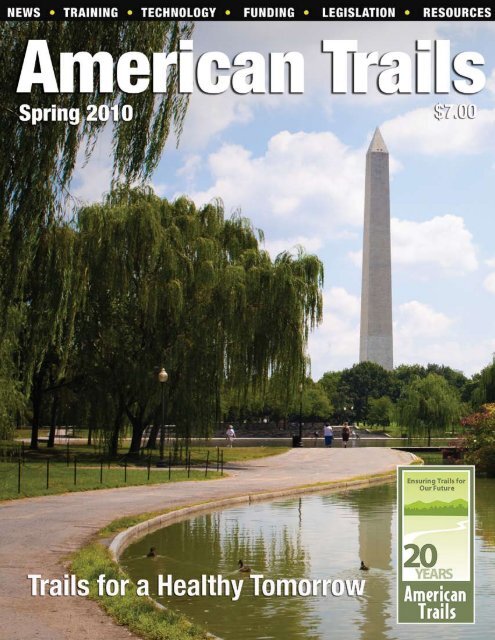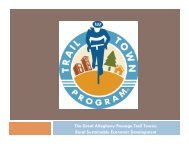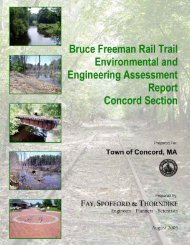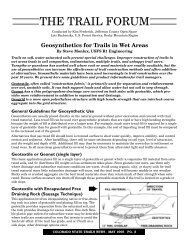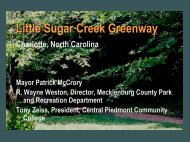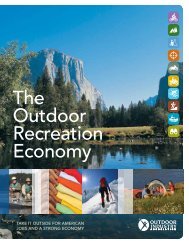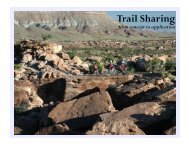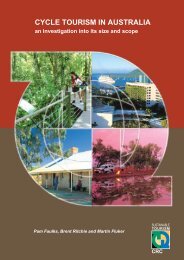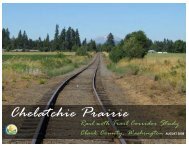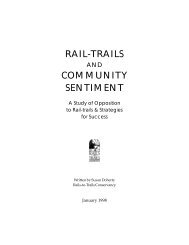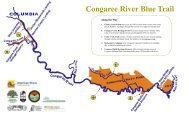20th American Trails National Symposium
20th American Trails National Symposium
20th American Trails National Symposium
- No tags were found...
Create successful ePaper yourself
Turn your PDF publications into a flip-book with our unique Google optimized e-Paper software.
Set the stage forwater trailsA new workshop from <strong>American</strong> <strong>Trails</strong>on developing and managing accessiblepaddling trailsBy Mike Passo, Owner, Elakah Expeditions (www.elakah.com) & <strong>American</strong> <strong>Trails</strong> Board MemberYou only get one chance to write your life story. Inwhich case, I would suggest gathering worthymaterial at your local water trail. Sure, you couldchoose a regular old land trail, or (God forbid)your office cubicle as the setting for your life story, butfrankly, it’s been done before.A water trail guides you through the unscripted tangentof land and sea, taking all the best of both, and weaving amagical tapestry of mystical costal inlets, rocky lakeshores,meandering river banks, eerily quiet backwater sloughs,and impossibly bright sand beaches. Here is where youcan find yourself refreshingly tucked away from the rest ofhumanity, providing the ideal environment for fosteringcreativity and forgetting conformity.A little overly dramatic, you say? Well… maybe.Now, one might wonder (with good reason) how do weget ourselves out to this magical setting? Admittedly, youcannot just throw on a pair of tennis shoes or hiking bootsand hit the trail, as you can with a land-based trail.Water trails demand not only something upon which youcan float, but they demand that you know how to use thatfloat, as well as the dynamics of the water. I do not wantto make light of this, because, as anyone that has tried toswim out through breaking waves or cross a fast movingstream knows, the power of water is astonishing and quiteunexpected.As with all trails, the user of the water trail can benefitgreatly from detailed and objective information aboutwhat they can expect when they venture onto this stage.Let us review the critical elements involved in the successfuluse of a water trail.Mike Passo teaching at the Water Trail Assessment and Adaptive Paddling Workshop6SPRING 2010 <strong>American</strong> <strong>Trails</strong>
Outfitters & trail managers– providing the boatThe local outfitter and agency manager is the first line ofdefense against uninformed or inappropriate use of thewater trail. Outfitters and managers should be preparedto make people aware of the minimum level of knowledgeand skill necessary to use a water trail (i.e. the “EssentialEligibility”). They should also have the equipmentand adaptations necessary to help people of all backgroundsand abilities to participate successfully.If they are prepared to serve all kinds of people in a safemanner, the water trail becomes easy and inspiring touse, for everyone. An open, informed, and willing personanswering the phone when a curious user calls makes awater trail much more accessible, right off the bat, withoutspending a dollar in physical upgrades.Wind, waves & currents– what happens whenthe water moves?Moving water is arguably the most enjoyable type ofwater. Unfortunately, it can also quickly sneak up and biteyou! The key is knowing:• Where and when the water moves• How exposed you may be to that movement at anygiven time• How to avoid being caught up in the movement whenyou are not prepared to beWater Trail Workshop offeredby <strong>American</strong> <strong>Trails</strong><strong>American</strong> <strong>Trails</strong> is proud to offer the Water TrailAssessment and Adaptive Paddling Workshop. Thisnew course is designed to help water trail managersand outfitters improve opportunities for people of allbackgrounds and abilities to enjoy water trails.The workshop includes a half day indoor instruction,followed by a half day of on-the-water training inadaptations and programmatic access.Call the America <strong>Trails</strong> office to learn more and toschedule a training in your area: (530) 547-2060.A water trail manager or outfitter that can simply andsuccinctly convey this information at key points alongthe water trail, makes a water trail much safer and moreusable to everyone.Transition/access points– crossing the unscriptedtangentThe greatest challenge for many people is crossing overfrom the land to the water. Mud, slick rocks, and steepwww.<strong>American</strong><strong>Trails</strong>.org7
Mike Passo discussing water access facilitiesbanks are now combined with floating bits that have theannoying tendency to move away from you when you tryto sit on them. Knowing that there is or is not a dock at alocation, or that the path accessing the water is or is notgentle and wide enough for a boat to be carried are veryimportant to the success of the day. Starting out a day onthe water with a wet bum causes even the hardiest of soulsto think twice about returning.Obstacles– things that may break your boat (notto mention you)This may be a little self-evident, but you will probably liketo know about the things that can run you over, drownyou, or just make your water trail life miserable. Thesecan be anything from hordes of mosquitoes, to wind andcurrent, to 900 foot super tankers traveling at 30 knots.You can avoid them, but only if you know they are there.What’s a good story without a few obstacles, anyway?Facilities– answering nature’s call, among otherthingsWhere do I park? Where do I camp? Where do I refillmy water? Knowing that your basic needs will be takencare of can be the difference between deciding to accepta new adventure, or clinging to the home front. The truthof the matter is that many people will not venture out ifthey think their only option for answering nature’s callinvolves anything remotely close to a bush and the softestleaves they can find. We are a fickle society.Armed with this information, you are ready to explore theworld’s water trails. The perfect setting. Unique characters.An ever changing plot. What are you waiting for?This puppy isn’t going to write itself.8SPRING 2010 <strong>American</strong> <strong>Trails</strong>
Paralympians urge kids to get activeBeing active is good for you, and it’s fun. So let’s get moving!By Peter Axelson and Manny GuerraThe 2010 Paralympic Winter Games, held recently inVancouver, celebrate spirit in motion. Athletes withdisabilities from around the world met to compete—inspiring and exciting the world with their performances— always moving forward and never giving up. Theseathletes remind us that when we work hard, we canachieve our dreams. We can all be sports champions.As Paralympic-level athletes,we were proud to competewith some of the best athletesin the world— we pushedour limits and had fun too.But you don’t need to be anOlympian to get moving.An important part of Let’sMove! is helping kids to stayphysically active and makingsure they have a healthy, balanceddiet. Children needphysical activity to behealthy and strong. Being Peter Axelsonactive can seem like a challenginggoal, but it startswith finding an activity thatyou enjoy and making it apart of your routine.It can be as simple as playingball or finding an adaptivesport like sled hockey ormono-skiing that’s right foryou. If you have a disability,there is adaptive equipmentavailable that can help youplay the sports you love.Parents can also play animportant role by beingactive together with their children. Find a physical activitythat the entire family can enjoy.Peter Axelson is a world champion mono-skier, founder ofBeneficial Designs (see pages 32-33), and Advisor to<strong>American</strong> <strong>Trails</strong>. Manny Guerra is a Paralympic gold medalistin sled hockey. Peter and Manny were part of thePresidential Delegation to the Closing Ceremony of theVancouver 2010 Olympic Winter Games.
<strong>Trails</strong>: The Green Wayfor AmericaThe theme for the <strong>20th</strong> <strong>American</strong> <strong>Trails</strong> <strong>National</strong><strong>Symposium</strong> is “<strong>Trails</strong>: The Green Way for America.”The idea of the theme is to evoke the benefit of trailsto America’s economy and environment. As weevolve toward a green economy, trails are the wayfor outdoor recreation and alternative transportation.<strong>Trails</strong> provide access and connections to many of thisnation’s most incredible green spaces: parks, forests, andwildlands. <strong>Trails</strong> are a critical component of green infrastructurewithin communities, tying homes to businesses,schools, and workplaces, and empowering clean humanpoweredmobility. <strong>Trails</strong> support the new <strong>American</strong> dreamwhich is built upon environmental and economic efficiency.<strong>Trails</strong> are, very simply, the green way for America.Call for Presentations/TopicsTo help us develop an exciting and motivating programfor the <strong>Symposium</strong>, we have invited the nationwide trailscommunity to submit ideas for presentations in support ofthe <strong>Symposium</strong>’s theme. We expect to offer 80 concurrentsessions, each lasting 75 minutes. Another opportunity, ina smaller scale format, to display information about yourproject or issue to a wide audience is creating a poster.Posters will be displayed in a common area throughoutthe <strong>Symposium</strong>. Individuals displaying posters will alsohave an opportunity to share their “story” and to meetwith interested attendees at designated times during the<strong>Symposium</strong>.The Program Committee has been particularly seekingpresentations that introduce new ideas, convey usefulstrategies, identify lessons learned, and strengthen participants’existing skills and knowledge — in the spiritof the <strong>Symposium</strong> theme. The Program Committee looksforward to receiving your ideas. Due to the tremendousnumber of proposals expected, we will not be able toaccept every proposal, and we may combine individualproposals with similar topics to create a Panel Session.For additional information about the program, please contactthe Program Committee Chair: Jeff Hunter, TennesseeField Organizer, Southern Appalachian Forest Coalition,PO Box 2142, Chattanooga, TN 37409, jeff@safc.org, (423)322-7866.The deadline for submitting proposals is April 9. Visitour website to download the complete instructions forsubmitting a proposal for a presentation at the 2010<strong>American</strong> <strong>Trails</strong> <strong>National</strong> <strong>Symposium</strong>:www.<strong>American</strong><strong>Trails</strong>.org/2010/call.html
<strong>American</strong> <strong>Trails</strong>’ 2010<strong>National</strong> <strong>Trails</strong> AwardsHonoring people and programs at the<strong>American</strong> <strong>Trails</strong> <strong>National</strong> <strong>Symposium</strong><strong>American</strong> <strong>Trails</strong> presents the <strong>National</strong> <strong>Trails</strong>Awards to recognize the exemplary peopleacross America who are working to create anational system of trails to meet the recreation,health, and travel needs of all <strong>American</strong>s. We will honoroutstanding efforts made by agencies, trail professionals,the private sector, corporations, media, and others at the<strong>National</strong> <strong>Trails</strong> Awards Banquet ~ On the Path ofExcellence on November 16, 2010 in Chattanooga, TN.The deadline for nominations is June 30, 2010.Award categories & criteriaTrail Advocacy Award(one award per state):For efforts to influencepublic policy relating totrail planning, trail protection,trail development,or maintenance.Trail Worker Award(one award per state):Recognizes the efforts ofa private or public sectorindividual working fortrail planning, development,or maintenance intheir local area or state.Best <strong>Trails</strong> State AwardRecognizes a state whichis facilitating an outstandingstatewide systemof trails, includingplanning, legislation,funding, and programs.<strong>Trails</strong> for Health AwardFor a community’sefforts to improve accessto trails and promotingtheir use for increasingphysical activity.Chattanooga, TN - November 14 – 17, 2010Bob Searns, Chair of <strong>American</strong> <strong>Trails</strong>, presents thePartnership Award to Ginny Sullivan at the 2008<strong>American</strong> <strong>Trails</strong> <strong>National</strong> <strong>Symposium</strong> in Little RockLifetime Service AwardFor an individual demonstrating long standing, significant,and exemplary service to trails planning, implementation,and recreation.Partnership AwardFor partnerships among private organizations, publicagencies, or public and private interests for the field oftrail planning, design, or implementation.<strong>Trails</strong> Public Service AwardFor agency staff, volunteers, or elected or appointed officialsat the Federal, state, or local level who have supportedtrail planning, design, or implementation throughstrong leadership and/or legislative efforts.Community Service AwardFor organizations that perform exceptional communityservice relating to, but beyond trail work, such as makingtheir communities better places to live, improving the naturalenvironment, or promoting volunteerism.Outstanding Media AwardFor efforts to provide positive public exposure and educationin the field of trail use, planning, design, or implementation,including free publicity for trails.<strong>Trails</strong> and the Arts AwardThe award recognizes outstanding publicart projects, interpretive signs, or othercreative structures associated with trailrelatedimprovements.Planning/Design AwardFor problem solving through innovativemethods, including public participationand/or public agency involvement toenhance trails.Corporate AwardA business or corporation must havedemonstrated significant, sustained, andexemplary service to trails planning.State-of-the-Art Technology AwardFor a trail-related product or service thathas significantly met a need, addressed anissue, or increased efficiency in traildesign, development, or maintenance.Outstanding Trail Sharing AwardThe award recognizes innovative and successfultrail sharing efforts, programs, andsystems.Kids and <strong>Trails</strong> Award: NEW AWARDThis award honors efforts to engage childrenand youth in outdoor experiencesusing, but not limited to trails. Creative,interpretive, educational, and/or recreationaldesign components are included, along with innovativeprograms which stimulate kids’ imaginations andpromote their interest in and appreciation for the naturalenvironment while developing healthy lifestyles.2010 <strong>National</strong> <strong>Trails</strong> Awards: See details and nominationforms at www.<strong>American</strong><strong>Trails</strong>.org/2010/awards.html
Recipients of the Developer Awards at the 2008 <strong>Symposium</strong>Developer AwardIn addition to the <strong>National</strong> <strong>Trails</strong> Awards, <strong>American</strong><strong>Trails</strong> also recognizes quality, well-designed multi-usetrails systems that are integrated into private developmentsto encourage active lifestyles, reduce relianceon automobiles, connect the development to other publicand private pathways and destinations, and preserve andpromote natural areas. See a link to the 2008 <strong>American</strong><strong>Trails</strong> Developer Awards given to three <strong>American</strong> communitiesat the <strong>National</strong> <strong>Trails</strong> <strong>Symposium</strong> in Little Rock atwww.americantrails.org/2010/awards.html.Registration andAccommodationsOnline registration will be available May 1. Thecost of registration will range from $325 earlyregistration for an <strong>American</strong> <strong>Trails</strong> member to$450 regular registration, non-member.Recognizing that budgets are tight, we will not be raisingthe rates this year.Lodging starts at $99 per night plus tax. A limited numberof rooms will be available at the prevailing governmentper diem rate at the time of the conference. Check the<strong>Symposium</strong> Web page at www.<strong>American</strong><strong>Trails</strong>.org/2010for our three host hotels and their contact information.Airfare and car rental information will be posted on the<strong>Symposium</strong> Web page as soon as it’s available.To learn more about Chattanooga visit:• www.outdoorchattanooga.com• www.discoversceniccity.com• www.tennesseeanytime.org/travelTo learn more about <strong>American</strong> <strong>Trails</strong> and the <strong>Symposium</strong>:• Visit www.<strong>American</strong><strong>Trails</strong>.org/2010• Contact (530) 547-2060 or symposium@<strong>American</strong><strong>Trails</strong>.org
Chattanooga, TN - November 14 – 17, 2010Tennessee RiverwalkGreenway along the city’s major river helped spur Chattanooga’s revivalBy Jim Bowen, Chattanooga Area RegionalTransportation Authority, and Candace Davis,Chattanooga Convention & Visitors BureauPhotos by Stuart MacdonaldNow into its second decade of development, theTennessee Riverwalk will form a 20-mile greenwaythrough Chattanooga. It stretches from theChickamauga Dam to downtown and out toMoccasin Bend, recently designated the country’s newestnational park and very first archeological district. Alongthe way, the trail links parks, green spaces, museums,public art, shops, fishing piers, boating facilities, andmiles of scenic Riverwalk along the Tennessee River.The Riverwalk experience begins at Ross’s Landing Plaza,a novel combination of landscaping, art, and architecturecreating a captivating public space that serves as the settingfor the Tennessee Aquarium and the ChattanoogaVisitors Center. The design incorporates exhibits, artifacts,and legends from Chattanooga’s history and geography.The Riverwalk extends out over the river and up on to theWalnut Street Bridge, a steel truss bridge built in 1890 thathas been renovated into one of the world’s longest pedestrianbridges. The bridge is perfect for strolling by day orby moonlight, and connects downtown to the numerousshops and restaurants along the north shore.The north shore is also home to Coolidge Park, whichhonors Charles B. Coolidge, a World War II Medal ofHonor recipient. It features an antique carousel furnishedwith animals carved by students of Chattanooga’s Horsin’Around carousel animal carving school. Children can cooloff in the interactive water fountains featuring large animals.Back on the south shore, the glass-bottom HolmbergBridge leads to the Hunter Museum of <strong>American</strong> Art andthe Bluff View Art District.Galleries and restaurants, as wellas a spectacular sculpture gardenoverlook the river. From BluffView, two pedestrian bridges leadto the historic Battery Place neighborhoodand the University ofTennessee at Chattanooga campus.Farther up the river, the Riverwalkpasses through the Centre SouthIndustrial Park and offers greatriver views of MacClellan Islandand the four downtown bridgesspanning the river.The final 4.5-mile segment connectingthe Rowing Center andthe Fishing Park along the southshoreline was completed in May2005. This newest Riverwalk componentadded three lighted parkingareas, numerous picnic facilities,and two public rest rooms.The bike-pedestrian Walnut Street Bridge (foreground) and the Market Street Bridge14SPRING 2010 <strong>American</strong> <strong>Trails</strong>
Cyclists and walkers enjoying the trails along the Tennessee River in ChattanoogaAlong the route are numerous river, creek, and wetlandoverlooks, and a grand, 360-foot pedestrian bridge. Thewalker, jogger, or bicyclist can travel on a 10-mile continuouspath along the southern shoreline from theChickamauga Dam to the Tennessee Aquarium and Ross’sLanding in downtown Chattanooga.The 21st Century Waterfront Plan was a sweeping $120-plus million vision that transformed the downtown riverfrontwith a careful combination of development, preservation,and enhancement. An aggressive schedule madethis transformation happen in 35 months. This uniqueplan evolved out of a public process that has become secondnature for Chattanoogans.The revitalization of Ross’s Landing Park is a cornerstoneof the plan. The project also reconfigured RiverfrontParkway, allowing for an enlarged and enhanced riversidepark. The trailhead of the Trail of Tears is honored atThe Passage. New docking facilities were added, the 1stStreet Sculpture Garden was created, reconnecting visitorsto the Hunter Museum of <strong>American</strong> Art (completed $19.5million expansion) in the Bluff View Art District. TheTennessee Aquarium also added a new saltwater addition(completed $30 million expansion). Additional workalong the north shore area has expanded Coolidge Parkwest of the Market Street Bridge to include the 23-acreRenaissance Park, a wetland park, and appropriatemixed-use development along Manufacturers Road.The 21st Century Waterfront Plan represents a major portionof the unfinished business begun with the TennesseeRiverwalk Master Plan and stands as a testament toChattanooga’s ability to forge bold visions punctuated byaggressive implementation. It is a blueprint for a riverfrontwithout rival. Already, housing, office, and retaildevelopments have totaled more than $750 million, makingcertain that this riverfront renaissance lasts well intothe 21st Century.See more photos and information about trails and greenwaysin Chattanooga and Tennessee on the 2010<strong>American</strong> <strong>Trails</strong> <strong>National</strong> <strong>Symposium</strong> website atwww.<strong>American</strong><strong>Trails</strong>.org/2010Greenway and <strong>Trails</strong> specialisTsin parTnership wiTh dhM desiGnBoardwalk section of the Tennessee RiverwalkThe Greenway Team303.904.9415 | www.GreenwayTeaM.coMwww.<strong>American</strong><strong>Trails</strong>.org15
Chattanooga, TN - November 14 – 17, 2010Vast new nature park opensRecycled ammunition plant becomes major trail site for ChattanoogaBy Gina Hatler, Hamilton County GovernmentEnterprise South Nature Park is Hamilton County’snewest and most prized public properties. Set toopen in October 2010, the 2,800 wooded acres willoffer visitors a rare opportunity to explore landthat has been heavily protected and largely left to flourishin its natural state for over 80 years!This immense tract of land is part of what used to be theVolunteer Army Ammunition Plant, known locally asVAAP. Consisting of over 7,000 acres located in the heartof the county, heavily populated on all sides, the area hasalways been closed to the public and heavily guarded.VAAP’s history stretches to World War II when the federalgovernment acquired the land for TNT production.Employment peaked at about 3,500 workers with varyingproduction over the years that also included the Koreanand Vietnam wars. Production ceased in 1977.In 1978 negotiations were started to acquire portions ofthe site for an industrial park, but it wasn’t until 2000that the city and Hamilton County were able to buy theheart of the acreage for use as an industrial park. It wasrenamed Enterprise South in 2002 and chosen as home ofthe new Volkswagen America Production Facility in 2008.Construction is now underway on the 940-acre plant andseveral surrounding equipment suppliers.The public enjoys a first look at the new parkVisitors explore one of the many subterranean storagebunkers remaining from the former ammunition plantThe 2,800 acres were conveyed to the City of Chattanoogaand Hamilton County in 2004 to be used as a nature parkdue to its hilly terrain and proximity to surrounding residentialareas. There are numerous remnants of the VAAPoperation still evident along the trails, including almost100 subterranean storage bunkers. Considerations fortheir possible use is still underway. Three of these will berestored as historical exhibits.The park will offer miles of walking paths, bikeways,off-road biking, and horse trails. There are ample areasfor picnics and a secluded two-acre lake that attracts deer,turkeys, and other wildlife.An equestrian trail-building workshop and tour of thefacility will be offered at the <strong>Symposium</strong> in November.See more about Chattanooga and Tennessee trails onthe 2010 <strong>American</strong> <strong>Trails</strong> <strong>National</strong> <strong>Symposium</strong> websiteat www.<strong>American</strong><strong>Trails</strong>.org/201016SPRING 2010 <strong>American</strong> <strong>Trails</strong>
Bridge provides opportunity for creativityHighway project evolves into park and trail projectBy Rick Herold, City of Grand PrairieDuring the planning process for extending StateHighway 161, the Texas Department of Transportation(TxDOT) determined that the most feasible alignmentthrough the city of Grand Prairie would result in theloss of about 10 acres of park land. Other options to avoidthe park produced negative impacts to residential areas.The highway project became mired in litigation andTxDOT proposed a settlement to mitigate the park impactby acquiring 62 acres of additional land and providing$10 million dollars in park improvements and amenities,concentrating on a linear trail connecting C.P. Waggoner Signs, landscaping, and artistic railings enhance the projectPark to Mike Lewis Park, approximately 1 mile north ofthe affected park. The overall vision ofTxDOT partnered with the City of Grandthis project was to enhance the two existingparks and create a natural corridorPrairie to reimburse the city for all acquisitioncosts. Improvements included constructionof 4.85 miles of accessible 14’linking the two parks with a fully accessibletrail that separates the user from thewide concrete trail. Due to the site conditions,a 250-foot pedestrian bridge had tourban environment.The consultant firm HNTB of Dallas wasbe constructed to cross Johnson Creek, acontracted to design the park improvements,in concert with Grand PrairieTrinity River. Three elevated boardwalksmajor tributary of the west fork of theParks and Recreation staff and representativesfrom TxDOT. Both parks are par-wetlands. Accessible ramps at six loca-were also constructed to access designatedtially located in the floodplain of the westtions provide trail users with access to thefork of the Trinity River and each featurelinear park.large wooded areas and a rich riparianFor more information contact Grand Prairieenvironment. The design team focused onParks & Recreation, P.O. Box 54045, Grandopportunities to protect and enhance thePrairie, TX 75054 - phone (972) 237-8375natural habitat, while encouraging trailRiver overlook structurewww.grandfungp.comusers to experience the outdoors.The trail bridge over Johnson Creek at duskwww.<strong>American</strong><strong>Trails</strong>.org17
Nat i o n a l Recreation <strong>Trails</strong>NRT Photo Contest winnersWe are pleased to announce the winners of the<strong>National</strong> Recreation <strong>Trails</strong> Photo Contest for2009. <strong>American</strong> <strong>Trails</strong> sponsors the annualcontest for photos of designated <strong>National</strong>Recreation <strong>Trails</strong> across the country. Awards in severalcategories highlight the diversity of the NRTs and introducemore <strong>American</strong>s to these great trails. See the winnersand all 240 photos entered in the contest on the NRT websiteat www.<strong>American</strong><strong>Trails</strong>.org/nationalrecreationtrails.TRAIL USE CATEGORIESHiking and Walking • photo by Eddie Gerritsen• Mount Timpanogos <strong>National</strong> Recreation Trail, UTEquestrian <strong>Trails</strong> • photo by Carl R. Knoch• Heritage Rail Trail County Park, York County, PAPaddling and Water <strong>Trails</strong> • photo by Karl King• Juniata River Water Trail, PABicycling • photo by John Reimer and Lorne Reimer• Maah Daah Hey Trail, NDVolunteers on the Ouachita Trail (photo by Loretta Melancon)Tunnel Hill State Trail, Illinois (photo by Jonathan Voelz)Admissible <strong>Trails</strong> • photo by Lloyd Smith• Woodlands <strong>National</strong> Recreation Trail, Jacksonville, ORTRAIL MANAGEMENTTrail Sharing • photo by Palisades District Staff, USFS• Palisades Creek <strong>National</strong> Recreation Trail, IDTrail Work • photo by Loretta Melancon• Ouachita <strong>National</strong> Recreation Trail, OKHealth and Fitness • photo by Carl R. Knoch• Heritage Rail Trail County Park, PAVolunteers • photo by Brooke Smith• George S. Mickelson Trail Trek Bicycle Ride, SDTRAIL FEATURESArts and Interpretation • photo by Mary Shaw• Great Allegheny Passage Trail, PARail and Canal <strong>Trails</strong> • photo by Jonathan Voelz• Tunnel Hill State Trail, Johnson County, ILInnovative Facilities • photo by Mary Shaw• West Penn <strong>National</strong> Recreation Trail, Bow Ridge, PAEnvironmental Features, Flora, and Fauna • photo by StanMalcolm• Raymond Brook Marsh, Hebron, CT, along the Air LineTrailScenery and Natural Features • photo by Marty Silver• Little Stony Creek <strong>National</strong> Recreation Trail, VAUrban <strong>Trails</strong> and Greenways • photo by Yves Zsutty• Guadalupe River Trail, San Jose Trail System, CA18SPRING 2010 <strong>American</strong> <strong>Trails</strong>
Artistic Merit • photo by Stephen Ausherman• Tent Rocks <strong>National</strong> Recreation Trail, Kasha-Katuwe Tent Rocks <strong>National</strong> Monument,NMHistoric Features • photo by Mary Shaw• Canal Locks in Saltsburg on the West PennTrail, PA (part of the Pittsburgh toHarrisburg Mainline <strong>National</strong> RecreationalTrail)If you enjoy photography, look up designatedNRTs in your area or next time you travel. We’llbe sponsoring another photo contest this yearwith a deadline for entries of December 15,2010. Learn more about the <strong>National</strong> Recreation<strong>Trails</strong> Program and see more photos at www.<strong>American</strong><strong>Trails</strong>.org/nationalrecreationtrails.Art at the Eastern Continental Divide on the Great Allegheny Passage Trail(photo by Mary Shaw)2009 <strong>National</strong> Recreation <strong>Trails</strong> Photo ContestSee all 240 NRT photos entered at www.<strong>American</strong><strong>Trails</strong>.org
<strong>Trails</strong> training opportunitiesA sampling of the many topics covered by courses and trainingoffered this year. See details on these opportunities and manymore on the online Training Calendar: www.<strong>Trails</strong>Training.net.Courses include Mountain Leadership School, BasicMaintenance Skills, Teen <strong>Trails</strong> Leadership Crew, CrosscutSaw Certification, and more.• www.outdoors.orgDavid Bartoo of Delaware State Parks teaching a group abouttrail designMOUNTAIN BIKINGSubaru/IMBA Trailbuilding SchoolThe International Mountain Bicycling Association hostsdozens of three-day Subaru/IMBA Trail Care courses. Theinteractive learning and hands-on trail work emphasizes“sustainable” trail building, which means building trailsthat last a long time and require minimal maintenance. Inaddition to basic trail design and construction, the coursesfocus on fostering volunteer clubs and partnerships.• www.imba.comALL TRAIL ACTIVITIESLeadership for <strong>Trails</strong> TrainingThe Outdoor Stewardship Institute of Volunteers forOutdoor Colorado hosts several training events aroundthe state including Crew Leader Instructor Refresher,Crew Chef Training, Ecological Restoration, CrewLeader Training for <strong>Trails</strong>, Working with Youth, Basic<strong>Trails</strong> Skills, and Wilderness First Aid & CPR.• www.voc.orgEQUESTRIAN TRAIL SKILLSBackcountry Horse SkillsNinemile Wildlands Training Center near Missoula,MT is hosting several workshops on backcountry horsetrail and packing skills. Classes include Defensive HorseSafety, Mule and Horse Packing, HorsemanshipTechniques, and Back Country Survival Techniques.• www.fs.usda.gov/loloHIKING and BACKPACKINGAppalachian Trail SkillsA great reason to join one of the chapters of theAppalachian Mountain Club is to take advantage ofthe training offered in several regions the trail traverses.22SPRING 2010 <strong>American</strong> <strong>Trails</strong>
Training in soil composition (photo by Cam Lockwood)ALL ORGANIZATIONSFund Raising and Grant WritingThe Center on Philanthropy at Indiana University hostsPrinciples & Techniques of Fundraising online and teachesclassroom sessions around the country in PreparingSuccessful Grant Proposals, Online Fundraising andSocial Media, Developing Major Gifts, and Fundraisingfor Small Nonprofits.• www.philanthropy.iupui.eduALL OUTDOOR RECREATIONISTSLeave No TraceTraining in the outdoor ethics program includes MasterEducator Courses for those who then teach the TrainerCourse to people who become Leave No Trace Trainers.Trainers (Master Educators) are thenable to conduct Awareness Workshops,which are designed for the generalpublic on Leave No Trace.• www.lnt.orgTread Lightly!Tread Lightly! sponsors Train-the-Trainer courses around the country withlocal hosts. The innovative, practicalmethods of spreading outdoor ethics tothe public use a curriculum specificallyfocused on motorized and mechanizedrecreation. Tread Trainers present theTread Lightly! message of responsiblerecreation practices to groups and othereducators.• www.treadlightly.orgTRAINING CALENDARA few notable upcoming 2010 events;see details at www.<strong>Trails</strong>Training.netApril 16-18 - Cascade Locks, OR• Trail Keepers of Oregon Trail Skills CollegeApril 20 - Seyon Ranch in Groton, VT• Vermont <strong>Trails</strong> and Greenways Annual meetingApril 21-23 - Cambria, CA• 2010 California <strong>Trails</strong> & Greenways ConferenceApril 28-29 - Martinsville, IN• Accessible <strong>Trails</strong> Training Course: 21st Century <strong>Trails</strong>May 14-16 - Oakridge, OR• High Cascade Forest Volunteers Trail Skills CollegeMay 15-17 - Guadalajara, Mexico• International Ciclovia – Car Free Sunday Study TourMay 18-20 - Portland, OR• Joint Conference: River Management Society and<strong>National</strong> Association of Recreation Resource PlannersMay 24-28 - Albuquerque, NM• <strong>National</strong> Landscape Conservation System Science<strong>Symposium</strong> includes <strong>National</strong> Scenic and Historic <strong>Trails</strong>June 10-12 - Great Barrington, MA• Northeast Trail <strong>Symposium</strong>June 16-20 - Marathon County, WI• Ice Age Trail University Mobile Skills Crew TrainingFor classes, conferences, and training opportunities, visitthe NTTP online calendar at www.<strong>Trails</strong>Training.net
TRAIL TRACKS EDITORIALTwenty life lessons of the trailThe trail allows us to experience others, our world, and ourselves in a unique andintimate way.By Ronald R. Bearwald, Ed.D.Traveling in a chosen mode at a pace that allows us toimmerse ourselves in the surrounding environment farsurpasses what we might experience as a passerby in aspeeding car. We are presented with both serenity and rigorsthat put us in touch with our own capabilities andsensibilities. We are stimulated by scenery and inhabitantsthat often escape our attention. Perhaps most importantly,in addition to the scenery, serenity, stimulation, and theintrinsic rewards that come with walking, hiking, andclimbing, the pathway uniquely presents life “lessons.”The Fisher Towers <strong>National</strong> Recreation Trail in Utah (photosby Stuart Macdonald)The trail can be a great teacher if we allow ourselves toreflect on the nature of our experience. In fact, the trail isa perfect metaphor for life itself. Like life, the trail has itsforks in the road which present us with decision points,its obstacles that slow our journey and test our resolve, itsever-changing terrain which demands that we adapt, itsinclines and descents which draw on different strengths,and its fellow travelers whose relationships enrich ourexperience. Sometimes the trail is hidden and worn, but itis always there waiting to be rediscovered. And, like life,the trail always leads somewhere. As we set aside ourtrail gear and resume our normal daily routines, ourmemories of the trail experience can easily translate into“lessons” that lead us to a better understanding of ourlives lived each day.Walking the trail requires intention.<strong>Trails</strong> abound. Selecting and walking the trail is not a passiveactivity. Whether we hike for function, conditioning,adventure, exploration or whether we seek solitude orengagement with the wonders of nature, we must intendto walk the trail. Bringing ourselves to our first steps onthe pathway requires purpose and commitment. Our purposesbring meaning to our steps along the trail.Some trails must be walked from the beginning whileothers may be joined at any point.While the designated trailhead provides a clear beginning,many trails have entry points along the way. If wechoose to start our journey at a point farther along thepathway, we must remain aware of what preceded usand seek information that will guide our direction.There are forks in the trail.Rarely do we encounter a trail without branches. Theseforks in the road are moments of decision. In deviatingfrom the determined path we may learn and experiencemore or we may detract from that which lies ahead bybranching off. It is important that we weigh our reasonsand the consequences of selecting the fork we choose.There are obstacles in the trail.No trail is without obstacles. We will encounter fallentrees, flooded streams, jagged rocks, and animals even onthe most well groomed trails. These obstacles are a way oftesting our mettle and sense of purpose while providingus with an opportunity to achieve more. Obstacles overcomehelp make our trip all the more memorable.24SPRING 2010 <strong>American</strong> <strong>Trails</strong>
Parts of the trail are oftenunmarked.While many things point the way, themarkers are not always clearly identifiable.We must deal with the uncertaintyof direction by tapping intoour experience, knowledge, skill,understanding and, sometimes, evenour courage. Our skills and knowledgeinfluence our decisions. Ourchoices guide the journey as it continues.The trail always leads somewhere.Some pathways lead to familiar andexpected destinations while othersopen us to new discoveries.Occasionally, either as expected orunexpectedly, the trail brings us backto where we started. When it seemsthat we are on a trail to nowhere, ourpatience and persistence determinehow far we travel.The terrain and landscape of thetrail changes. The trail is dynamic, not static.The pathway presents a variety of terrain and landscapes.Clay and stone give way to the soft cushion of moss andfallen pine needles. Sun-baked meadows may be replacedby damp soil by a forest stream. As we continue, weadapt to the changing character of the trail and relishwhat if offers.
TRAIL TRACKS EDITORIAL Twenty life lessons of the trail (continued)Parts of the trail are more challenging than others.We may encounter inclines, descents, curves, changingweather, weather extremes, and other tests and obstaclesof nature. Each challenge urges our active engagementwith what we encounter in the environment as we chartour way. The ebb and flow of the trail’s demands remindus that life is not linear and opens us to learning moreabout our strengths and needs in dealing with change.The difficulty of the trail is relative.Some days we encounter trails that are challenging; onother days an easier path awaits. The relative difficulty ofthe trail is defined by both the condition of the trail andwhat we are able to bring to the trail. As we understandour part in determining the relative difficulty of our trailwe can better appreciate the rewards we experience.Sometimes the trail doubles back so that we can reachhigher ground.Often the trail is not linear, a straight line between twopoints. Sometimes the trail curves and even doubles backon itself. The zigzag pattern of the trail keeps us frombeing discouraged by an incline that is too steep to conquerall at once. By following the side-to-side pathway,we are able to maintain our resolve to carry on.Descending may be more rigorous than climbing.We sometimes resist a trail that declines, as it seems counterto reaching higher ground or the summit. However,the valleys, canyons, meadows, and streams that lay atthe end of the descent provide an enriching new perspective.Each descent conditions our bodies and minds foreach and refreshes us to climb higher.26SPRING 2010 <strong>American</strong> <strong>Trails</strong>
We will meet others along the trail.Most contact is likely to be in passing, but remaining opento contacts and conversation to be more expansive willenrich your trail experience. Directly or indirectly youhave shared an experience with those you meet along amutually traveled path. In doing so you have become partof each other’s trail experience that will only be rememberedif you are present to these contacts when they occur.Some trails should not be walked alone.The trail offers a fulfilling solitude to those who choosethe singular stroll. However, on treacherous trails a travelingcompanion provides the counsel and protection thatensures our safety or survival. While hiking alone offersits own rewards, companionship becomes essential alonga threatening pathway.Resting along the trail allows one to complete thejourney.Fatigue, that often comes on suddenly and unexpectedlycan ultimately prevent us from concluding our walk. Bycarefully monitoring the demands that the trail is placingon our body and allowing for purposeful rest in the shortterm,we can preserve a long-term and continuing experienceon the trail.Walking the trail requires nourishment.While water and food seem the most obvious form ofnourishment, resting along the way to enjoy or photographthe view, journaling our experience, conversing,or soaking our feet in a stream can also sustain us. Mostimportantly we must consciously seek and provide ourselveswith opportunities for nourishment.The trail and its surroundings are one.The pathway is but a part of a larger and intertwinedenvironment. Like most ecosystems each individual partaffects and relies on all of the other parts for survival andlife. While on the trail, remember that we are a living partof the of the trail’s ecosystem and travel respectfully.The trail is always there.Once a trail is blazed it is always there waiting to be rediscovered.But when washed away, covered by snow,hidden by overgrowth, or faint from disuse, we have towork a little harder to find it. The hidden trail alwayswaits as a pathway to our destination.The trail is multi-sensory.The movement of our body against the trail and the sightswe see predominate our experience. We feel the elementsagainst our skin. We smell the wildflowers or pine needleson the trail bed. We hear the sounds of water and wildlife.Even silence catches our attention. We must use all of oursenses to appreciate the full impact of the trail.Walking the trail mindfully is often more rewardingthan hurrying to the finish.It is easy to get caught up in the notion that completingthe trail is the overriding goal of our efforts. Our motivationto achieve the finish may close us off from many richand rewarding experiences and images along the way.Our memories of the trail are significantly enriched whenwe remain mindful and attentive to all that the surroundsour every step of the journey.The trail becomes more memorable through reflection.In order to give each trail experience a lasting place in ourmemory, we must actively and consciously reflect on itsmeaning. What new sights, sounds, challenges, and peopledid we encounter? What did we learn about the trail?What did we learn about ourselves? Finding time toreflect through journaling, cataloging images, and sharingwith others will help create lasting memories of our trailexperience.As we follow our trail through urban, rural, or wildernesssettings, pay close attention to the “messages” that canenrich our experience. Reflecting each day on the unique“lessons” of our trail experience helps us better understandourselves and each other, and promotes appreciationfor our world. The trail has been, and will continue tobe a great teacher.“Each day is a journey, and the journey itself is home.”— Matsuo Basho, Haiku MasterDr. Bearwald is a professional services consultant in educationwith teaching expertise in educational leadership,instructional systems, and educational policy development,and communications.www.<strong>American</strong><strong>Trails</strong>.org27
NEW RESOURCESSome recent articles, studies, and photo galleries at www.<strong>American</strong><strong>Trails</strong>.orgValuing Bicycling’s Economic andHealth Impacts in WisconsinThis new study estimates the economic impact of bicyclerecreation and tourism in Wisconsin to be$924,211,000, and the total potential value of health benefitsfrom reducing short car trips and increasing bicycletrips to total $409,944,167. The study demonstrates thatbicycling has the potential to contribute substantially tothe health and economic well-being of Wisconsin citizens.The report includes data from surveys, analysis of the keytopics with bicycling, and recommendations for actionsand policies by communities, agencies, and organizations.Topics covered include:• Economic impact of bicycle tourism and recreation• Valuing bicycling’s impact on health• Gathering evidence for investments in bicycling infrastructureSee the link to this study under “Benefits and Economics“ atwww.<strong>American</strong><strong>Trails</strong>.org/resources/newest.htmlUnlike bridges, railings are typically not used on lowwater crossings, although the structure may be wider thanthe normal trail width. Similar structures are used to carrytrails over streams under road bridges. Narrow channelsmay be cut in the concrete to allow moderate water flowthrough rather than under the trail itself.See this and more recently added photo galleries in our“Cool Trail Solutions” area at www.<strong>American</strong><strong>Trails</strong>.org/resources/cool/Schuylkill River Greenway land dealbenefits public as well as industrySchuylkill River <strong>National</strong> and State Heritage Areaworked with Brentwood Industries to acquire andconstruct a trailhead facility in Reading, PA. The trail is aplanned, 130-mile regional facility between Pottsville andPhiladelphia. For the community, a manufacturing plantwas able to expand basic sector employment, the kind ofemployment that generates secondary employment in theservice sector of the local economy.The property, now back on the tax roles, was vacant fordecades, producing little or no taxes to support the City ofReading, the Reading School District, and Berks County.The project also closed a gap in Reading’s trail section,making it possible to travel uninterrupted from the centerof Reading 6.75 miles to the village of Gibraltar.See the link to this study under “Benefits and Economics“ atwww.<strong>American</strong><strong>Trails</strong>.org/resources/newest.htmlLow water crossing on Cherry Creek Trail, Denver, ColoradoNew Cool Trail Solutions gallery:low water stream crossingsLow water crossings for trails are typically concretestructures near water level. Much wider than culverts,these structures cross over drainageways at thesame grade as the trail surface. Low water crossings aredesigned to allow normal flow under the trail, and to beover-topped during seasonal floods. Concrete is the normalmaterial used to withstand flooding and scouringfrom flowing water.Complete GPS trail condition survey and mapping service:• Easy to read flexible printed reports, digital photos, allassociated tables plus “raw data” in any format• Customized feature codes for any database• Map sizes from pocket to kiosk available• Customized data dictionaries available• 30 years of trail building experience(530) 583-9128 • trailcontractor@sbcglobal.netwww.trailbuilders.org/donald_hays.html28 SPRING 2010 <strong>American</strong> <strong>Trails</strong>
NEW PRODUCTSTechnology for trails and greenwaysPathway GuideLite systemlights the way for trail usersOne challenge for trail managers is to provide theappropriate lighting system for different situations.An interesting solution for some applications is a solarpoweredrechargeable lighting system.Arbor Glow, Inc. is the manufacturer of a lighting deviceto mark the location of pathways, sidewalks, and varioustypes of trails in total darkness. The “Pathway GuideLite”system serves as a series of low light-level beacons toidentify the pathway’s route at night. The GuideLite willemit a long-lasting steady glow that continues for at least15 hours at a light intensity 100 times greater than thehuman eye can perceive.The Pathway GuideLite does not rely on reflective lightor any electrical power source. There are no undergroundcables to install and there is no maintenance needed. ThePathway GuideLite fully recharges through normal daylightexposure to extend its glowing time through the followingnight darkness, and is sustainable for up to100,000 recharge cycles. The Pathway GuideLite is easilyrecognized in darkness from 40 feet away, providing safetybenefits to all pathway and sidewalk users.Trail Markers come in 3” X 6” panels so an 18 square inchsize is now offered. Custom sizes can also be produced.The secure mounting is typically 16 inches above theground level. The product is <strong>American</strong>-made from metal.For more information contact John Valenta at arborglow@cox.net.Simulation of the Pathway GuideLight in use on a trail
<strong>American</strong> <strong>Trails</strong> Patron MembersWe’d like to thank these important supporters of <strong>American</strong> <strong>Trails</strong>’ work◆ Arrowhead <strong>Trails</strong>, Inc.◆ Bellfree Contractors, Inc.◆ Blue Ember Technologies, Inc.◆ City of Little Rock, AR◆ Ditch Witch◆ Christopher Douwes◆ East Bay Regional Park District, CA◆ EZ Dock◆ Jefferson County Open Space, COEZ DockEZ Dock is the leading floating dock and PWC lift manufacturer.Our patented floating dock system is themost stable, low-maintenance, and durable system available.Our modular designs and dock accessories make itEZ to create the perfect waterfront setting.Contact EZ Dock, 878 East Highway 60, Monett, MO65708 or call toll free (800) 654-8168. Visit the website atwww.ez-dock.com.◆ Kansas Dept. of Wildlife & Parks◆ Mt. Shasta Products, CA◆ Minnesota Recreational Trail UsersAssociation, Inc.◆ Pioneer Bridges◆ <strong>Trails</strong>.com, Inc.◆ USDA Forest Service - <strong>Trails</strong> Unlimited◆ Voss Signs, LLCWelcome new <strong>American</strong> <strong>Trails</strong> Patron Member!More details at www.<strong>American</strong><strong>Trails</strong>.org/patrons.html
PEOPLE IN THE NEWSThe leaders and volunteers who are helpingcreate trails for all <strong>American</strong>sDale Shewalter, founder of theArizona TrailDale Shewalter, known as the “Father of the ArizonaTrail,” and guiding spirit for the Arizona TrailAssociation (ATA), died January 10. According to theATA, Dale had a vision of a continuous path acrossArizona, and in 1985 he undertook a journey on footacross the state. Following that experience, Dale begansharing his trail idea throughout Arizona to many peopleand agencies.The idea quickly took hold and within a few years theArizona Trail idea was born. Today the 819 mile ArizonaTrail is nearly complete and was congressionally designateda <strong>National</strong> Scenic Trail in 2009. Dale’s positive spirit,sense of cooperation, and refusal to give up are still theArizona Trail Association’s operating style.In 2008 <strong>American</strong> <strong>Trails</strong> presented Dale Shewalter withthe State Advocacy Award for Arizona. The citation reads:“While walking from the Mexican border to the Utah border,he visualized and tentatively mapped an interlockingroute of trail systems traversing the state from south tonorth. The concept of the Arizona Trail was born, offeringopportunities for hikers, equestrians, mountain bicyclists,and cross-country skiers to experience the rich diversityArizona has to offer.”Dale Shewalter at a recognition event in 2006Dale with his horse CimmaronTHE ARIZONA TRAILBy Dale R. Shewalter, February 1, 2003In the land of ArizonaThrough desert heat or snowWinds a trail for folks to followFrom Utah to Old Mexico.It’s the Arizona TrailA path through the great SouthwestA diverse track through wood and stoneYour spirit it will test.Some will push and pedalAnd some will hike or runOthers will ride their horse or mule.What else could be more fun?Oh, sure, you’ll sweat and blisterYou’ll feel the miles each dayYou’ll shiver at the lonelinessYour feet and seat will pay.But you’ll see moonlight on the borderlandsYou’ll see stars on the MogollonYou’ll feel the warmth of winter sunAnd be thrilled straight through to bone.The aches and pains will fade awayYou’ll feel renewed and wholeYou’ll never be the same againWith Arizona in your soul.Along the Arizona TrailA reverence and peace you’ll knowThrough deserts, canyons, and mountainsFrom Utah to Old Mexico.www.<strong>American</strong><strong>Trails</strong>.org31
Beneficial Designs works for accessible trailsWorking toward universal access through research, design & educationBeneficial Designs develops assessment systems and devicesto give people the information they need to access avariety of environments. Other work involves new technologiesto improve the quality of life for people with disabilities.Peter Axelson founded Beneficial Designs in 1981 and hasbeen an Advisor to <strong>American</strong> <strong>Trails</strong> for many years. [See moreabout his work with skiing and healthy kids on page 9.]According to Peter, “We are developing new technologies withUSDA and FHWA government-funded research and developmentthat will improve the efficiency of conducting assessmentsof trails and public rights-of-ways.”Current projects include:UTAP & TrailWare 2.0 WorkshopsThere are currently 1,044 trail enthusiasts trained to leadassessments using the Universal Trail Assessment Process(UTAP). In addition to workshops held recently inCalifornia and North Carolina, Florida continues to leadthe way in providing training to their trails personnel andwas presented a “Best <strong>Trails</strong> State” award by <strong>American</strong><strong>Trails</strong> in 2008.Trail assessment coordinatorsare involvingvarious groups to assistin the UTAP process,including Girl Scouts,4-H Clubs, and highschool and college students.BeneficialDesigns provides thetraining materials andtools through PaxPress,while <strong>American</strong> <strong>Trails</strong>coordinates most UTAPtraining courses.TrailWare 2.0 is used togenerate trail accessinformation, signage,and trail managementreports. Data is uploadedto the Trail Explorerwebsite at www.trailexplorer.org.For moreinformation, contacttrails@beneficialdesigns.com.One of Beneficial Designs’ Trail Access Information signs onthe Truckee River greenway trail in Reno, NevadaRecreation <strong>Trails</strong>We are working on our third Nevada Recreational <strong>Trails</strong>Program project to provide signage in Northern Nevada.The goal is to continue making Trail Access Information(TAI) widely available in Northern Nevada for a varietyof trails and trail users. In 2007/2008, we assessed 29 trailstotaling 37.8 miles. A total of 80 TAI signs and 9 full panelcolor trail signs were created and installed. This year, wehave assessed 103 miles of trail and are creating full colortrail maps and TAI signs for at least 12 different parks.Tahoe Meadows (near Lake Tahoe)This project is designed to improve trail access and opportunitieswhile protecting the natural and archeologicalresources within and around Tahoe Meadows. In cooperationwith the U.S. Forest Service and Nevada State Parks,three new loop trails totaling 3.4 miles have been built orimproved, including 1,200 feet of boardwalk along OphirCreek. Two new stair sets and a new turnpike have alsobeen constructed. Completion of this project is anticipatedin 2010 with a new bridge over Ophir Creek, an interpretivesign, multiple directional signs, and a trails map.High Efficiency Trail Assessment ProcessThis project created the Wheeled Instrumentation SensorPackage (WISP) to collect more accurate, objective informationabout trails, including shared use paths, backcountrysingletrack trails, and cross-country ski trails. Todate, 70 trails have been assessed in Northern Nevadausing the new system. Multiple HETAP systems havebeen purchased by state and city land managers and the<strong>National</strong> Park Service in Florida, Arizona, and Canada.This system has been commercially available throughBeneficial Designs for the past year.Accessible Trail Gate BarrierThe goal of this project is to design an electronic trail gatebarrier that can be used with or without a mechanical trailgate barrier to restrict access to motorized trail vehicles,and allow access to personal mobility device users. Thesystem uses infrared heat detection technologies to detectand report violations by motorized vehicle users.Surface AccessibilityThe Rotational Penetrometer (RP) measures the firmnessand stability of trail surfaces, carpet, and other pedestrianroutes. The RP is commercially available throughBeneficial Designs. It is currently under review as anASTM standard test method for the measurement of surfacefirmness and stability.32SPRING 2010 <strong>American</strong> <strong>Trails</strong>
Peter Axelson demonstrating the Accessible Trail Gate BarrierA Standardized Assessment Process of OutdoorRecreation FacilitiesThis project will create methods for assessing the accessibilityof recreation elements used for outdoor recreation,picnic and camping facilities, such as picnic tables, firerings, and water pumps.Public Rights-of-Way Assessment Process to DetermineAccessibilityBeneficial Designs developed a manual sidewalk assessmentprocess (SWAP) to systematically measure elementswithin the pedestrian environment, such as curb rampsand driveway crossings. In phase I, we were able to automatethe process to reduce the time to perform assessmentsto 20% of the time required to perform assessmentsmanually. We have added a laser to measure transitionheights to detect tripping hazards. We have submitted arequest to the Federal Highways Administration (FHWA)for Phase II funding to develop a commercial product.Adaptive Ski Equipment StandardsPeter Axelson is chair of the Rehabilitation Engineeringand Assistive Technology Society of North America(RESNA) standards committee that developed specificationsand test methods for adaptive ski equipment. Thestandard was published in December of 2007 as a RESNA<strong>American</strong> <strong>National</strong> Standard. The committee meets eachyear in December in conjunction with the Ski Spectacularevent in Breckenridge, Colorado.Canoe Seating SystemThe Universal Design Canoe Seat is finished and is nowcommercially available! The seat replaces the existingbench seat. It provides adjustable pelvic, back, and lateralsupports to improve balance and comfort. For more information,contact Chosen Valley Canoe Accessories at (507)867-3961 or cvca@gear4portaging.com.For information about Beneficial Designs, visit the websiteat www.beneficialdesigns.com.<strong>American</strong> <strong>Trails</strong> coordinates workshops on both the UTAPand TrailWare. Read more about these courses atwww.<strong>American</strong><strong>Trails</strong>.org/nttp/ATworkshops06.html
BOOK reviewsTrail planning guidenew book that originated inA California will be of great helpto trail planners across the country.Trail Planning for CaliforniaCommunities offers planners, advocates,developers, and trail managersa comprehensive approach fortransforming their vision into reality.Based on the premise that successfultrail development depends on communityinvolvement throughout thelife of the project, the book alsoassumes that every component ofdesign, construction, maintenance,and funding must be considered duringthe early stages of the processand reassessed as the project movesfrom planning to implementation.While the book is essential for thoseworking on Golden State projects,the sheer level of detail andthe comprehensive coverageof every trail issue makesthis a valuable resourcenationwide:• Purpose & Value of <strong>Trails</strong>• Policies and Regulations• Building the TrailCommunity• Legal Rights and Concerns• Trail Design• Environmental Reviewand Permitting of <strong>Trails</strong>• Funding <strong>Trails</strong>• Maintenance & OperationsThe book received theOutstanding EnvironmentalResource Document Awardfor 2010 from the CA chapterof the Association ofEnvironmental Professionals.Read more about the 429-page book from Solano Pressat www.solano.com or call(800) 931-9373 to order.Conservation and LandAcquisition HandbookThe NEPA Book is subtitled “AStep-by-Step Guide on How toComply with the <strong>National</strong>Environmental Protection Act.“Anyone seeking grants for work onfederal lands needs to have a workingknowledge of NEPA. Thenation’s oldest and far-reaching environmentallaw, NEPA applies to allfederal agencies and most of theactivities they approve or carry out.The NEPA Book includes:• Detailed advice on how to complywith NEPA• Expanded discussions of EAs andEISs, as well as Findings of NoSignificant Impact (FONSIs)• Flow charts and diagrams explainingthe entire NEPA process• How to integrate NEPA with otherenvironmental laws• Resources for NEPA compliance• The globalization of NEPA• Discussions of important case law• Recent advisory memoranda onthe implementation of NEPAThe 470-page book is available fromSolano Press at www.solano.com or(800) 931-9373.34SPRING 2010 <strong>American</strong> <strong>Trails</strong>
<strong>American</strong> <strong>Trails</strong> Member OrganizationsBecome an organizational member of <strong>American</strong> <strong>Trails</strong>!Our members are continuing to help us advocate for your interests and making it possible to provideyou access to thousands of trails and greenways resources on the <strong>American</strong> <strong>Trails</strong> website!Memberships starting at $50 for nonprofits and $100 for businesses.Join and review all the benefits online today at www.<strong>American</strong><strong>Trails</strong>.org or fill and mail in the membership form on page 37.SUPPORTERS• Anasazi <strong>Trails</strong>, Inc.• Arkansas Game and Fish Commission• Asphalt Systems, Inc.• Austin Parks Foundation• Back Country Horsemen of America• Roger Bell• Beneficial Designs, Inc.• Biological Mediation Systems, Inc.• Wiley Blankenship• Bowman-Melton Associates, Inc.• Brooks Jeffrey Marketing• City of Aspen, CO• City of Bloomfield, NM• City of Boise, ID• City of Hope, AR• City of Lewistown, MT• City of Oldsmar, FL• City of Shasta Lake, CA• Coffman Studio• Colorado Springs Parks & Recreation• Contech Bridge Solutions• Cumberland Trail Conference• Delaware State Parks• Donald A. Neptune, A.I.A.• Equestrian Land Conservation Resource• Florida DEP-Office of Greenways &<strong>Trails</strong>• Forestoration, Inc.• Kandee & David Haertel• Hancock Resources LLC• Hill Country Conservancy, TX• Indiana Trail Riders Association, Inc.• John Deere & Company• Johnson Co. Park & Rec. District• Logansport Memorial HospitalFoundation• Longleaf Trace• Loris and Associates, Inc.• Los Alamos County Parks Division• Methow Valley Sport <strong>Trails</strong> Assn.• Minnesota DNR, <strong>Trails</strong> & WaterwayDivision• Motorcycle Industry Council• <strong>National</strong> Park Service - RTCA• Palmetto Conservation Foundation• Pannier Graphics• Papio-Missouri River Natural ResourcesDistrict• Pinal County Parks, Rec, & Fairgrounds,AZ• Project Groundwork• S.W. Leader, Inc.• Shaw-Weil Associates• Sibilsky & Associates• South Dakota Game, Fish, & Parks• Specialty Vehicle Institute of America• Terrabilt, Inc.• The McConnell Foundation• The Murphys Realtors, Inc.• Trail Food Express• Trail Management Services LLC• TrailArts• <strong>Trails</strong> 4 All• Trees Forever• Tri-Cities Visitor & Convention Bureau,WA• Wheeler Lumber, LLC• Whitney Portal Store & Hostel• Willow Creek Community ServicesDistrictAFFILIATES• <strong>American</strong> Horse Council• Audubon Center at the Francis BeidlerForest• Bicycle Colorado• Bike-Walk Alliance of New Hampshire• BLM - Redding, CA• Blue Ribbon Coalition• Brazos River Authority, TX• Broad River Greenway, NC• Bylines• California Assn of RV Parks &Campgrounds• California Center for Physical Activity• Chelan-Douglas Land Trust, WA• Chicagoland Cycling Meetup• City of Clayton, MO• City of College Station, TX• City of Leominster, MA• City of Orange Beach, AL• City of Wylie Parks & Recreation, TX• Commonwealth of Kentucky• Connecticut Forest & Park Assn• Continental Divide Trail Alliance• Davis County C.E.D., UT• Dillon Nature Center• East Arkansas Planning & DevelopmentDistrict• East Coast Greenway Alliance• Five Rivers MetroParks, OH• Florida Greenways & <strong>Trails</strong> Foundation,Inc.• Florida Trail Association• Forest Preserve Dist. of DuPage Co., IL• Gallatin Valley Land Trust, MT• Greater Memphis Greenline• Greene County Partnership - Tourism, TN• Greers Ferry Lake <strong>Trails</strong> Council, AR• Hoosier Rails to <strong>Trails</strong> Council• Hulet Hornbeck• Iditarod <strong>National</strong> Historic Trail• International Snowmobile Mfg. Assn.• Iowa Natural Heritage Foundation/Mississippi River Trail• Irvine Ranch Conservancy• Kentucky Horse Council• La Canada Flintridge <strong>Trails</strong> Council, CA• Lebanon Recreation & ParksDepartment, NH• Lee County Parks and Recreation, FL• Louisiana Office of State Parks• Lowell Parks and Conservation Trust, MA• Miami and Erie Canal CorridorAssociation, OH• Michigan Snowmobile Association• Emily Meyerson• Meadwestvaco• <strong>National</strong> Association of RecreationResource Planners• Northwestern Indiana RegionalPlanning Commission• Northwestern Ohio Rails-to-<strong>Trails</strong> Assn.• Nova Scotia DNR• Jeff Olson• Parks & <strong>Trails</strong> Council of MN• Katheryn Peck• Pennsylvania Wilds GreenwaysPartnership• Peoples Advocacy for <strong>Trails</strong> Hawaii(PATH)• Poplar Bluff Parks & Recreation, MO• Quad Cities Convention & VisitorsBureau• Rapid City Dept. of Parks & Recreation,SD• Redlands Conservancy, CA• Allison Renck• Ride with Respect• Ridge <strong>Trails</strong> Association, FL• Rivanna <strong>Trails</strong> Foundation• Snowmobile North Dakota• Sonoma Cty. Agricultural Preservation &Open Space Dist.• Southern Off-Road Bicycle Association• St. Charles County Parks & Rec.• Sterling Park District, IL• Tahoe Pyramid Bikeway• Tahoe Rim Trail Association• Teton Valley <strong>Trails</strong> & Pathways• The Catamount Trail Association, VT• The Corps Network• The Greenway Team, Inc.• The Trail Foundation, TX• Town of Collingwood, Ontario• Trail Mix, Inc.• <strong>Trails</strong> & Bikeways Council of GreaterRedding• <strong>Trails</strong> & Open Space Coalition• <strong>Trails</strong>cape.net• Ukiah Valley Trail Group• Vermont Assn. of Snow Travelers, Inc.(VAST)• Volunteers for Outdoor Colorado• Volunteers for Outdoor Missouri• Wallkill Valley Rail Trail Assn.• Warrenton <strong>Trails</strong> Association
FEATURED NATIONAL RECREATION TRAILAustin loves its lakefront trailAbove: Bridge links trails on both sides of Lady Bird LakeLeft: Guitars are the theme for art along the trailButch Smith, who helped with the survey, noted:“Early one July morning, I stationed myself near one ofthe busiest trailheads to launch the survey. As I watchedthe many young and fit runners go through a pre-runwarm-up, the thought came to mind that this trail hasprobably replaced the bar scene as a place for singles toget together. But then, as I looked around, I noticed peopleof all walks of life on the trail. There were older peopleout for a stroll, dog walkers, moms pushing babystrollers, bicycle riders, and friends walking along deep inconversation. In our fast-paced, automobile-based society,it is hard for people to come together and share their time.Evidently, people have found this opportunity out on theTown Lake Trail and they are enjoying the experience.”See more photos and information on the Trail at Lady BirdLake on its Featured <strong>National</strong> Recreation Trail page atThe Trail at Lady Bird Lake is one of the most wellusedtrails in America. Formerly called Town Lakewww.<strong>American</strong><strong>Trails</strong>.org/nationalrecreationtrails.Visit The Trail Foundation at www.townlaketrail.org.Trail, the 10-mile path was designateda <strong>National</strong> Recreation Trail in 1975.The trail came to life during the 1970sthanks to a public-private civic effortled by the Citizen’s Committee for aMore Beautiful Town Lake and itsHonorary Chairwoman, Lady BirdJohnson. In 2003, the Town Lake TrailFoundation (now The TrailFoundation) was formed to continuethe work of the Citizen’s Committeeand ensure that the Trail remains oneof Austin’s outstanding places.The Austin Parks and RecreationDepartment conducted a survey inthe 2003 in order to learn more abouttrail users, and how to improve theirexperience.Afternoon rush hour on the Trail at Lady Bird Lake36 SPRING 2010 <strong>American</strong> <strong>Trails</strong>
Join the <strong>American</strong> <strong>Trails</strong> Network Today!Please help us protect and grow our trail funding.The time is now, and we need your help!Save time— join or renew online now!Or print this page and mail in with your payment.Visit our website at www.<strong>American</strong><strong>Trails</strong>.orgto view all the benefits of membership and to learn more about the work we do.____ Associate (Individual) $25OR Get our 2-year special rate of $45____ Subscription (Agency/Library/Individual) $35OR Get our 2-year special rate of $60____ Affiliate (Nonprofit/Individual) $50OR Get our 2-year special rate of $90____ Supporter (Business/Agency/Nonprofit/Individual) $100OR Get our 2-year special rate of $175____ Patron (Business/Agency/Nonprofit/Individual) $250OR Get our 2-year special rate of $450Free Pin for New MembersPlease consider making an additional donation to our programs:____ <strong>American</strong> <strong>Trails</strong> Programs $_________ THANK YOU!____ <strong>National</strong> Recreation <strong>Trails</strong> Program $ _________ THANK YOU!Make checks payable to AMERICAN TRAILS, and mail to: PO Box 491797, Redding, CA 96049-1797Phone: (530) 547-2060. Form may also be faxed if paying by credit card to (530) 547-2035.If paying by credit card:____Visa ____ Master CardCard #________________________ Exp. ____________Name on Card ___________________________________ Signature __________________________________Contact Name ___________________________________ Organization _______________________________Address ________________________________________ City ______________________________________State _______ ZIP ______________ Phone _________________________ Fax _________________________E-mail _______________________________________ Website ______________________________________Thank you!<strong>American</strong> <strong>Trails</strong> does not discriminate on the basis of race, color, sex, national origin, religion, age, or ability.www.<strong>American</strong><strong>Trails</strong>.org37
2009 <strong>American</strong> <strong>Trails</strong> Website ContestWinning WebsitesCheck out the winners of the 2009 <strong>American</strong><strong>Trails</strong> Website Contest. It’s the only nationalcontest to recognize trail-related websites deliveringeffective information, supporting volunteers, andengaging the public. Encouraging others in the trailsworld to study these good examples of websites is justone of the ways we support trails across America (andCanada). For links to the WinningWebsites and dozens of nominatedsites, visit www.<strong>American</strong><strong>Trails</strong>.org.q State agency siteMinnesota Water <strong>Trails</strong> provides a listof water trails, maps, trip planning,water levels, safety, and recommendedreading.q <strong>Trails</strong> on federal landsNM Rails-to-<strong>Trails</strong> Association volunteerswork to convert abandonedrail lines in the Sacramento Mountains of southern NewMexico into multi-use trails, while saving historic trestles.q Community trails system websiteClear Creek Trail is Kitsap County’s (WA) stream andriparian area preservation project.q Trail organization or club websiteMulleyville Snowmobile Club (NY) provides a forum forstewardship and information on the NY state trail systemwith photos, trail updates, and volunteer events.q Designated <strong>National</strong> Recreation Trail websiteCliff Walk <strong>National</strong> Recreation Trail along the easternshore of Newport, RI is famous as a public access walkthat combines natural beauty with architectural history.q Personal site (site developed by an individual)Mike’s Hikes, created by Mike Molloy, provides trails,hiking, and snowshoeing reports and photos in the RockyMountain <strong>National</strong> Park and Estes Park, Colorado area.q Presentation of plans and proposalsFriends of Lafitte Corridor is dedicated to preserving thegreenway corridor since Hurricane Katrina gave specialpriority to rethinking the New Orleans landscape.q Education and trainingGwynns Falls Trail runs 15 miles along the Gwynns Fallsstream to the Middle Branch and the Inner Harbor of thePatapsco River in Maryland and includes detailed graphicsof all informational panels on display along the trail.Award winners are entitled to use the“Winning Website” logo on their sites.q Graphics and site designYork County Rail Trail Authority (PA) is a prime exampleof how a private business and a public agency can partnerto provide trail information to the trail community.q Best use of photographsGreat Rivers Greenway District highlights the River Ring,a 600-mile region-wide system of greenways, parks andtrails in the St. Louis region.q Trail finding and database siteUtahMountainBiking.com: BruceArgyle has ridden, photographed,mapped, and described in detail over300 trails spanning the state of Utah.q Trail tour or virtual visitCumberland Trail will pass through11 eastern Tennessee counties; siteincludes a wealth of maps and traildescriptions for the long-distance hiker.q Travel and tourism site for trailsDelaware & Lehigh <strong>National</strong> Heritage Corridor (PA) helpsvisitors on boat, bike, or foot find trailheads and points ofinterest along the 165-mile path.q Promotion of trail ethics and trail sharingRidge to Rivers offers trail maps, routes, and trail conditionsfor the Boise, Idaho foothills, and encourages responsibletrail use during the wet winter months.q Accessible trailsWisconsin State Parks, <strong>Trails</strong>, and Forests provides detailsof many of the 650 miles of trails that are accessible towheelchair users and others with mobility impairments.q Recognition and promotion of volunteerismEast Bay Regional Park District (CA) supports a programthat includes Trail Maintenance Volunteers, Public SafetyVolunteers, and Regional Parks Ambassadors.q Health and exerciseAlbuquerque Prescription <strong>Trails</strong> Pilot Program providesprescriptions for walking and wheelchair rolling and awalking guide with directions and bus route access.q Trail-related business or productLoris and Associates, Inc. provides many examples ofdesign solutions for urban corridors and shared-use paths,as well as mountain trails, with bridges, retaining walls,underpasses, and other facilities.For links to the Winning Websites and dozens ofnominated sites, visit www.<strong>American</strong><strong>Trails</strong>.org38SPRING 2010 <strong>American</strong> <strong>Trails</strong>
Save the dates: Nov. 14-17, 2010 for the<strong>American</strong> <strong>Trails</strong> <strong>National</strong> <strong>Symposium</strong>!NON-PROFITORGANIZATIONU.S. POSTAGE PAIDJEFFERSON CITY,MOPERMIT NO. 210P.O. Box 491797Redding CA 96049-1797MAXIFORCE TMTraffic Control Bollards


